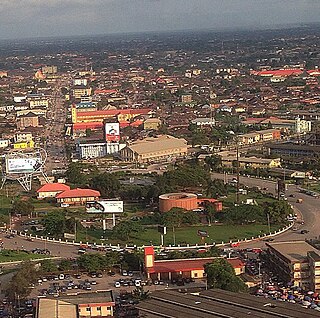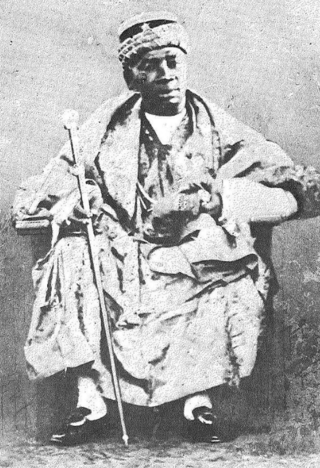
Iga Idunganran is the Official Residence of the Oba of Lagos, situated on Lagos Island. [1] [2] [3] It is also a tourist attraction.[ citation needed ]

Iga Idunganran is the Official Residence of the Oba of Lagos, situated on Lagos Island. [1] [2] [3] It is also a tourist attraction.[ citation needed ]
Dating back to the 15th century, the Lagos Island was originally owned by the island's first inhabitant Chief Aromire, an Ile-Ife nobleman, who used it as a fishing port and pepper farm. [4] The ancient palace was initially built in 1670 for Oba Gabaro (1669-1760). [5] It was later refurbished by the Portuguese, with materials — especially tiles — brought in from Portugal. [6]
The modern part of the complex was completed and commissioned on 1 October 1960 by the Prime Minister of Nigeria, Sir Abubakar Tafawa Balewa. [7] Recently modernized by the Obas Adeniji Adele II and Adeyinka Oyekan II, it underwent additional modernization in 2007 and 2008 by the present Oba, Akiolu, in conjunction with the Lagos State government and the Nigerian Museum. [8]
Iga Idunganran has served as an administration centre, the island's market and the venue of the Eyo festival. [9]
IGA, derived from the Oyo/Ife Yoruba language GAA meaning Royal Home or Palace, IDUN means land, place or sound of while IGANRAN is the Yoruba word for pepper. Iga Idunganran therefore translates to "the palace built on a pepper farm", Aromire having used the land previously as his farm. [10] [11] [12]
All the Obas of Lagos before Oba Akitoye are buried in Benin City. Oba Akitoye was the first Oba of Lagos to be buried within the modern palace. All subsequent Obas except Sanusi Olusi and Kosoko are buried at Iga Idunganran. [7] [13]
A number of shrines to the orishas exist in the palace. These include:
Esu (pronounced Éshu) can be found at the exit gate of the Palace.. The Oba and his chiefs prayed at this shrine to ward off danger to Lagos (and later Nigeria generally) in times past. They also prayed there prior to leaving the palace for any private or official function to ward off evil. Moreover, before going out, the Oba is supposed to visit this shrine in order to be told how his journey will be. Questions such as whether the journey will be favourable and whether it is safe for the Oba to embark on such a journey would typically be asked.
Ogun is the god of iron. Though not within the palace per se, there is a small edifice constructed for immediate access in the complex's grounds. The main shrine is situated outside the present walls of the palace, though it still falls under its jurisdiction. It has a priestess who handles its day-to-day running.
Special rites and prayers are performed every sixteen days in the palace, usually by the Araba of Lagos, Chief Ajanaku, though the Oba does on occasion use other traditional priests and priestesses depending on the priority and the occasion, and the perceived spiritual prowess of such people. Some of the items necessary for performing these rituals are bitter kola, kola-nuts, alligator pepper, palm oil, schnapps or any plain gin, chickens, pigeons, goats or rams and anything else the Ifa oracle may decree, short of a human life.
In the aftermath of the 2020 End SARS protests, Iga Idungaran was looted and the Oba of Lagos, Rilwan Akiolu accused the looters of carting away $2m and ₦17m from his palace. [14] [15] [16] [17] [18]

Benin City serves as the capital and largest metropolitan centre of Edo State, situated in southern Nigeria. Notably, it ranks as the fourth-most populous city in Nigeria, according to the 2006 national census, preceded only by Lagos, Kano, and Ibadan.

Ifẹ̀ is an ancient Yoruba city in south-western Nigeria founded sometime between the years 500 BC-1000 BC. By 900AD, the city had become an important West African emporium producing sophisticated art forms. The city is located in present-day Osun State. Ifẹ̀ is about 218 kilometers northeast of Lagos with a population of over 500,000 people, which is the highest in Osun State according to population census of 2006.

Lagos Island is the principal and central Local Government Area (LGA) in Lagos, Nigeria. It was the capital of Lagos State until 1957. It is part of the Lagos Division. As of the preliminary 2006 Nigerian census, the LGA had a population of 209,437 within an area of just 8.7 km2. The LGA only covers the western half of Lagos Island; the eastern half is simply referred to as Lagos Island East LCDA.

Lagos is the largest city of the West-African country of Nigeria, and its former capital; it is the largest city in Africa in terms of population with about 15.3 million people. It is also the 4th largest economy in Africa.

The Oba of Lagos, also known as the Eleko of Eko, is the traditional ruler (Oba) of Lagos.
Oba is a pre-nominal honorific for kings in Yorubaland, a region which is in the modern republics of Benin, Nigeria and Togo. Examples of Yoruba bearers include Oba Ogunwusi of Ile-Ife, Oba Aladelusi of Akure, and Oba Akiolu of Lagos. An example of a Bini bearer is Oba Ewuare II of Benin.
Akitoye, sometimes wrongly referred to as Akintoye, reigned twice as Oba of Lagos; first, from 1841 to 1845, and a second time, from 1851 to 1853. His father was Oba Ologun Kutere and his siblings were Obas Osinlokun and Adele.

The Eyo Festival, otherwise known as the Adamu Orisha Play, is a Yoruba festival unique to Lagos, Nigeria and has a strong historical footing in Iperu-Remo, a town in Ikenne Local Government, Ogun State. In modern times, it is presented by the people of Lagos as a tourist event. Due to the history of its development, it is traditionally performed on Lagos Island. A notable festival date was in 2000 commemorating Justice G.B.A. Coker, a Lagos high chief, the Olori Adimu and the Olori Eyo of the Adimu Eyo cultural masquerade.
The following is a timeline of the history of the metropolis of Lagos, Nigeria.

The Olojo Festival is an ancient festival celebrated annually in Ife, Osun State, Nigeria. It is one of the popular festivals in the Yoruba land, and was once described by Oba Adeyeye Enitan Ogunwusi as a festival that celebrates the Black race all over the world. The Yoruba word 'Olojo' means 'The Day Of The First Dawn' that describes the grateful heart of man towards God's creation and the existence of Human. The Olojo Festival is a culture festival in the calendar of the Ile-Ife, Osun State which is located in the Southwestern part of Nigeria. It is the celebration of the remembrance of “Ogun”, god of Iron, who is believed to be the first son of Oduduwa, progenitor of the Yoruba people. The festival is held annually in September/October. Although, in 2019 it was observed in February. It is one of the biggest festival on the culture calendar of lle-Ife.
Ibikunle Alfred Akitoye (1871–1928) was Oba of Lagos from 1925 to 1928 during what some historians refer to as the "Interregnum" years of the exiled Oba Eshugbayi Eleko. Ibikunle Akitoye was the first western educated and Christian Oba of Lagos. Akitoye's reign also marked the association of Lagos Obas with non-traditional religions.

Oba Sanusi Olusi was a wealthy trader who succeeded Ibikunle Akitoye as Oba of Lagos from 1928 to 1931 during what some historians refer to as the "Interregnum" years of the exiled Oba Eshugbayi Eleko. Oba Sanusi Olusi was a grandson of Olusi, and great grandson of Oba Ologun Kutere. Sanusi Olusi was the first Muslim Oba of Lagos.
Oba Gabaro who reigned from 1669–1704 was the third Oba of Lagos, son and heir to Oba Ado, and grandson of Ashipa. His siblings were Akinsemoyin, and Erelu Kuti.
Oba Eshugbayi Eleko, alias "Eleko of Eko", was the Oba of Lagos from 1901 to 1925, and from 1931 to 1932. His father was Oba Dosunmu. Eleko's struggles and legal victory over the British colonial government symbolized the struggle between indigenous rights and colonial rule in Nigeria. The outcome of the "Eleko Affair" led to the Eleko's deposition as Oba and deportation to Oyo between 1925 and 1931, years that some historians now call the "interregnum years", and that saw the reigns of Oba Ibikunle Akitoye and Oba Sanusi Olusi.

Rilwan Babatunde Osuolale Aremu Akiolu is the incumbent Oba of Lagos.
Adelekan Olubuse I was the 46th Ooni of Ife, a paramount traditional ruler of Ile Ife, the ancestral home of the Yorubas. He succeeded Ooni Derin Ologbenla and was succeeded by Ooni Adekola.
Ologun Kutere reigned as Oba of Lagos from around the 1780s to around 1803. He succeeded Oba Eletu Kekere who reigned between 1775 and 1780. "Ologun" is the Yoruba word for "War General".

Kosoko was a member of the Ologun Kutere Lagos Royal Family who reigned as Oba of Lagos from 1845 to 1851. His father was Oba Osinlokun and his siblings were Idewu Ojulari, Olufunmi, Odunsi, Ladega, Ogunbambi, Akinsanya, Ogunjobi, Akimosa, Ibiyemi, Adebajo, Matimoju, Adeniyi, Isiyemi, Igbalu, Oresanya, and Idewu-Ojulari.
The Eletu Odibo of Lagos is the traditional nobleman that has historically served as the principal kingmaker of the Oba of Lagos. As head of the Akarigbere class of chiefs, the Eletu Odibo also serves as the prime minister of the Oba.

Yoruba architecture describes the architectural styles of the Yoruba people of West Africa, dating back to approximately the 8th century. and lasted up to and beyond the colonial period beginning in the 19th century CE.